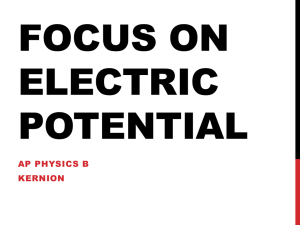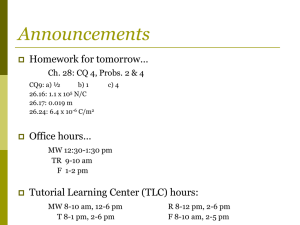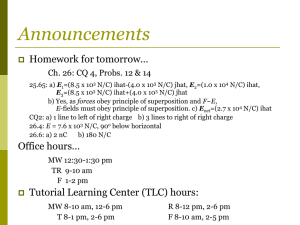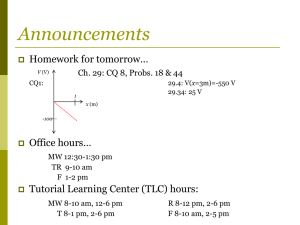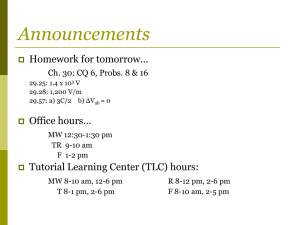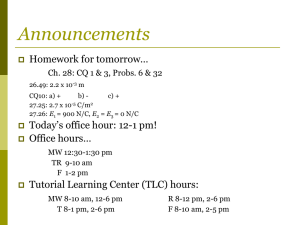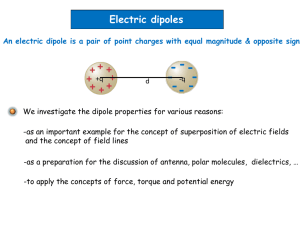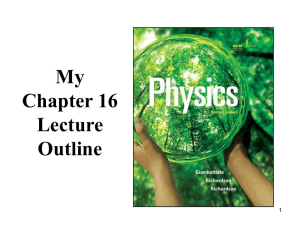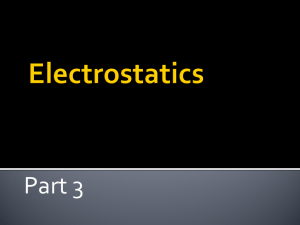Chapter 21 Electric Charge and Electric Field
advertisement
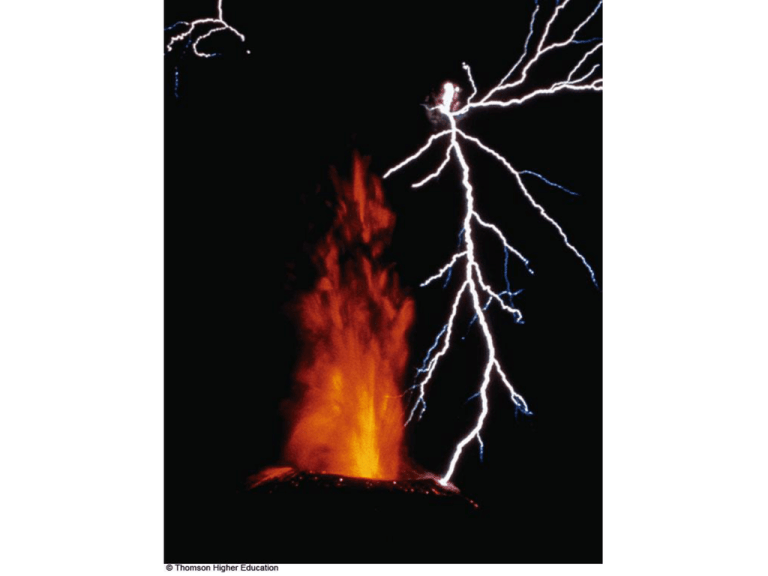
Electricity and Magnetism Why you should care… - basis of operation for all electronics - makes you more marketable - electric and magnetic forces are the foundation for almost all physical processes in your daily life - Formation of solids and liquids - Sense of touch - Lots of things Ch 23.1 – Electric Charges The electric force is a fundamental force of nature (like gravity). The amount of charge a body has determines its ability to generate electric force. The amount of charge a body has also determines its ability to ‘feel’ electric force. No charge? Then no electric force exists. Charge? Then electric force exists. Ch 23.1 – Electric Charges This is really similar to gravity. If two bodies have mass, they will interact via gravitational force. If two bodies have charge, they will interact via electric force. The difference? Mass is mass, but there are two types of charge. Positive Charge – protons. Negative Charge – electrons. Charge in the Atom • • • • Protons (+) Electrons (-) Ions Polar Molecules Ch 23.1 – Electric Charges the Paula Abdul Rule… Opposite charges attract one another. Like charges repel one another. Ch 23.1 – Electric Charges Most big things in the universe have no net charge. On a big scale, things usually don’t interact via electric force. However, charges can be transferred from one object to another, resulting in net charge. Ch 23.1 – Electric Charges Big, important physical principle… Conservation of Charge In an isolated system, charge is neither created nor destroyed, only transferred from one place to another So, when you rub a glass rod on a piece of silk, friction causes electrons to jump off the glass and onto the silk. The silk takes on a net negative charge. The glass takes on a net positive charge. Ch 23.1 – Electric Charges Big, important physical principle… Quantization of Charge The smallest known packet of charge is the amount stored in one electron. Robert Millikan (1909) discovered that charge always occurs in integral multiples of this fundamental amount. Charge is a quantized thing. We give the special symbol e to represent the absolute magnitude of the electron’s charge. - An electron has charge -e - A proton has charge +e Bobby Millikan Ch 23.2 – Induction Induction is the process of sucking charge off an object without actually touching it. More in a moment. But first… Classes of Materials Conductors Have ‘free,’ unbound electrons, which can move about in the object. E.g., metals Insulators Can store net charges, but the charges aren’t free to move about. E.g., wood, plastic, humans Semiconductors Can act like conductors or insulators, depending on the conditions. E.g., silicon, GalliumArsenide, AluminumGallium-Arsenide, Gallium-Nitride, other weird alloys. The process of Induction Step 1: Start with a neutral conductor. Step 2: Bring a charged object close. Like charges repel, opposite charges attract. Step 3: Provide a reservoir to which free charges can flow from the conductor. In electronics, we call this the “Earth” or “ground.” Step 4: Remove the earth. Step 5: You now have a charged conductor. Yippee, Hooray! The process of Induction Step 1: Start with a neutral conductor. Step 2: Bring a charged object close. Like charges repel, opposite charges attract. Step 3: Provide a reservoir to which free charges can flow from the conductor. In electronics, we call this the “Earth” or “ground.” Step 4: Remove the earth. Step 5: You now have a charged conductor. We caused this net charge using induction. Yippee, Hooray! The Electroscope Ch 23.2 – Induction Charging an object via induction doesn’t require any contact with the object. In contrast, charging an object via conduction does require contact. -like rubbing the glass with the silk. Ch 23.3 – Coulombs’s Law Coulomb’s Law tells us how the electric force acts. It’s the electric analog to Newton’s Law of Universal Gravitation. Charles Coulomb – (1736-1806) French physicist famous for experimenting with the electric force. Ch 23.3 – Coulombs’s Law Coulomb’s Law Fe ke q1 q2 r 2 This is Coulomb’s Law in scalar form. It tells you the strength of the electric force on one charged object due to another, but it doesn’t tell you about the direction of the force. Ch 23.3 – Coulombs’s Law The magnitude of the charge on object 1. Coulomb’s Law The magnitude of the force on one particle due to the other. Fe ke Coulomb’s Constant – a universal constant that dictates how much force a given amount will generate. q1 q2 r The magnitude of the charge on object 2. 2 The distance of separation between the centers of the two objects, squared. Ch 23.3 – Coulombs’s Law Things to note… Coulomb’s Law, like Newton’s Law of Gravitation, is an inverse-square law. The force between to charges gets smaller like the inverse of the square of the distance between them. Coulomb’s constant is just that… constant. It always takes value: ke 1 4 0 8.9876109 N m 2 / C2 The units of charge are called Coulombs. The magnitude of the amount of Coulombs on a single electron is: e 1.602181019 C E.g. 23.1 – The Hydrogen Atom The electron and proton of a hydrogen atom are separated (on average) by a distance of about 5.3 x 10-11 m. Find the magnitudes of the electric force and the gravitational force between the two particles. Ch 23.3 – Coulombs’s Law Coulomb’s Law – vector form Force exerted by object 1 on object 2. q1q2 F12 ke 2 rˆ12 r Unit vector pointing from object 1 to object 2. Ch 23.3 – Coulombs’s Law Electric forces follow the law of superposition. If more than one charge is causing a force on object 1, then the net force acting on object 1 is just the sum of all the individual forces acting on 1. F1 F21 F31 F41 ... E.g. 23.2 – Find the Resultant Force Three point charges are located at the corners of a right triangle, where q1 = q3 = 5.0 μC, q2 = -2.0 μC, and a = 0.10 m. Find the resultant force exerted on q3. E.g. 23.3 – Where is Net Force Zero? Three point charges lie along the x axis. The positive charge q1 = 15.0 μC is at x = 2.00 m. The positive charge q2 = 6.00 μC is at the origin. The net force acting on q3 is zero. What is the x coordinate of q3? E.g. 23.4 – Find the Charge on the Sphere Two identical small charged spheres, each having a mass of 3.0 x 10-2 kg, hang in equilibrium as shown. The length of each string is 0.15 m, and the angle θ = 5.0 degrees. Find the magnitude of the charge on each sphere. Ch 23.4 – The Electric Field A more elegant way to think of the same information. Electric forces arises when one charged object acts on another. But, imagine if there were only one charged particle in the universe (we’ll call it the source charge). Would the source charge’s electrical nature be any different just because it’s alone? Ch 23.4 – The Electric Field In our model, we assume the electric nature of charge is intrinsic to the existence of charge. Charge, by virtue of being charge, creates an Electric Field. If you have charge somewhere in the universe, then you have an electric field. The effects of a given electric field can be tested by measuring how a secondary test charge responds to the field. Ch 23.4 – The Electric Field In math, we define a source charge’s (q) electric field in terms of the force it would exert on a test charge (q0) if the test charge were present. This is a tricky, abstract concept. Think about it. First, let’s pretend the test charge is in the picture, sitting a distance r away from the source charge. We can write down the force on the test charge. From Coulomb’s Law, it’s: qq Fe ke 20 rˆ r Ch 23.4 – The Electric Field qq Fe ke 20 rˆ r Now, let’s play a trick. Let’s divide the test charge out of the picture. Fe qq0 q ˆ ke r ke 2 rˆ 2 q0 q0 r r This is what we call the electric field. It is a measure of the amount of force exerted per unit of test charge at some point in space. Fe E q0 Ch 23.4 – The Electric Field The Electric Field Fe E q0 The amount of force a test charge would feel at some point in space. The amount of charge in the test charge. Electric Field – The force per unit charge. The electric field is a vector quantity. It has units of [N/C]. The E-field tells you how much force will be generated per unit charge at some point in space. Ch 23.4 – The Electric Field The Electric Field Fe E q0 Things to note… The electric field exists independently of the test charge. The existence of the E-field is a property of the source charge. The test charge serves as a detector of the E-field. An electric field exists at some point in space if a test charge at that point experiences an electric force. Ch 23.4 – The Electric Field The Electric Field Fe E q0 Fe q0 E Here’s the point… Often, we’ll be able to find the electric field at some point in space. Once we know the E-field, that means we know the force that some charge will experience at that point in space! This is the power of the electric field theory. Ch 23.4 – The Electric Field – E-field of a Point Charge Consider a really small ‘point’ charge, called q. This charge creates an E-field at all points in space surrounding it. Let’s put a test charge, q0, at point P, a distance r away from q. By Coulomb’s Law, q0 will experience a force… qq0 Fe ke 2 rˆ r … remember, r-hat points from q to q0. Ch 23.4 – The Electric Field – E-field of a Point Charge So, the electric field at point P can be found by dividing out q0. q E ke 2 rˆ r The E-field a distance r away from a point charge, q. Ch 23.4 – The Electric Field – E-field of a Point Charge So, the electric field at point P can be found by dividing out q0. q E ke 2 rˆ r The E-field a distance r away from a point charge, q. If the source charge is positive, the E-field points away. If the source charge is negative, the E-field points toward it. Ch 23.4 – The Electric Field – E-field of a Point Charge q E ke 2 rˆ r This field exists regardless of whether we introduce a test charge. The E-field a distance r away from a point charge, q. The electric field is a real thing. An E-field surrounds every charged particle in the universe. 2D representation of a point charge’s vector E-field. The actual vector E-field extends radially outward in all 3 dimensions. Ch 23.4 – The Electric Field The E-field is a vector thing. If i point charges generate E-fields at some point in space, the overall E-field at that point is the algebraic sum of all the individual component fields. q Enet ke 2 rˆi i ri The net E-field at point P due to i point charges. E.g. 23.5 – Electric Field of a Dipole Charges q1 and q2 are located on the x axis, at distances a and b, respectively, from the origin. Find the components of the net E-field at point P, which is on the y axis. Evaluate the E-field at point P in the special case that q1 q2 and a b. Ch 23.5 – Electric Field of a Continuous Charge Distribution We know how to find the E-field of a single point charge. Now, let’s jam a bunch of point charges together. Can we find the E-field they’ll create? We’ll pretend the charges are so close to each other that they are basically a continuous ‘smear’ of charge. Ch 23.5 – Electric Field of a Continuous Charge Distribution We’ll consider three cases… 1. Charge continuously packed along a 1-D line. A linear charge density. 2. Charge continuously smeared over a 2-D surface. A surface charge density. 3. Charge continuously spread throughout a 3-D volume. A volumetric charge density. Ch 23.5 – Electric Field of a Continuous Charge Distribution A linear charge density. If a total charge Q is uniformly distributed along a line length l, then the linear charge density, λ, along the line looks like: Q l Units: C/m Ch 23.5 – Electric Field of a Continuous Charge Distribution A surface charge density. If a total charge Q is uniformly distributed across a surface area, A, then the surface charge density, σ, across the surface looks like: Q A Units: C/m2 Ch 23.5 – Electric Field of a Continuous Charge Distribution A volumetric charge density. If a total charge Q is uniformly distributed throughout a volume, V, then the volumetric charge density, ρ, throughout the volume looks like: Q V Units: C/m3 Ch 23.5 – Electric Field of a Continuous Charge Distribution To find the E-field generated by a continuous distribution: Consider a small amount of charge in the distribution, Δq. At P, Δq generates an E-field we can find using the point charge E-field equation… q E ke 2 rˆ r The small E-field generated at P by the small charge Δq. Ch 23.5 – Electric Field of a Continuous Charge Distribution The overall E-field at P will be the sum of all the contributions from all the little charge bundles in the orange blob. qi E ke 2 rˆi ri i The net E-field at P due to all the charge in the blob. Ch 23.5 – Electric Field of a Continuous Charge Distribution The overall E-field at P will be the sum of all the contributions from all the little charge bundles in the orange blob. qi E ke 2 rˆi ri i The net E-field at P due to all the charge in the blob. In the limit the chunks of charge become infinitesimally small. qi dq rˆi ke 2 rˆ 2 qi 0 ri r i E ke lim E.g. 23.6 – Electric Field of a Charged Rod A rod of length l has a uniform positive charge per unit length λ and a total charge of Q. Calculate the electric field at a point P that is located along the long axis of the rod and a distance a from one end. E.g. 23.7 – Electric Field of a Charged Ring A ring of radius a carries a uniformly distributed positive total charge Q. Find the E-field due to the ring at a point P lying a distance x from its center along the central axis perpendicular to the plane of the ring. E.g. 23.8 – Electric Field of a Charged Disk A disk of radius R has a uniform surface charge density σ. Find the E-field at a point P that lies along the central perpendicular axis of the disk and a distance x from the center of the disk. Ch 23.6 – Electric Field Lines If we really wanted to know everything about the vector electric field surrounding a charge, we’d need to draw an infinite number of vectors. This would be cumbersome. Drawing Electric Field Lines is easier. Electric field lines are not the same as the vector electric field. But they do represent the same information. Ch 23.6 – Electric Field Lines Electric Field Lines… The actual E-field vector always points tangent to the electric field line. The direction of the electric field line indicates the direction of the actual E-field vector at that point. The number of field lines per unit area through a perpendicular surface is proportional to the magnitude of the E-field in that region. E-field lines penetrating two surfaces. The magnitude of the E-field is greater on surface A than on surface B. Ch 23.6 – Electric Field Lines The Rules… E-field lines always begin on positive charges. E-field lines always terminate on negative charges. If there is more positive charge than negative charge in your picture, some field lines will go out to infinity. If there is more negative charge than positive charge, some field lines will come in from infinity and terminate on the negative charge. Ch 23.6 – Electric Field Lines The Rules (cont.)… The number of lines drawn leaving a positive charge (or approaching a negative charge) is proportional to the magnitude of the charge. No two field lines will ever cross. Ch 23.6 – Electric Field Lines The E-field lines of a symmetrical dipole Ch 23.6 – Electric Field Lines The E-field lines of two equal positive charges Ch 23.6 – Electric Field Lines The E-field lines of an asymmetrical dipole Ch 23.7 – Motion of a Charge in a Uniform E-Field What happens when we place a charge q of mass m into a uniform E-field? The E-field causes a force on the charge! That’s what E-fields do! Assuming the electric force is the only force acting on q, then we know: Fnet ma Fe ma But… Fe qE qE ma qE a m Ch 23.7 – Motion of a Charge in a Uniform E-Field If the E-field is uniform, the electric force is constant. Thus, the acceleration will be constant. If the q is positive, the mass will accelerate in the same direction as the E-field. If the q is negative, the mass will accelerate against the E-field. qE a m E.g. 23.9 – An Accelerating Positive Charge A uniform E-field is directed along the x axis between parallel plates of charge separated by a distance d as shown. A positive point charge q of mass m is released from rest at point A and accelerates to point B. Find the speed of the particle at B, modeling it as a particle under constant acceleration. Find the speed of the particle at B, modeling it as a nonisolated system. E.g. 23.10 – An Accelerating Electron An electron enters a uniform E-field with vi = 3.00 x 106 m/s and E = 200 N/C. The horizontal length between the plates is l = 0.100 m. Find the acceleration of the electron while it is in the E-field. Assuming the electron enters the field at t = 0, find the time at which it leaves the field Assuming the vertical position of the electron as it enters the field is yi = 0, what is its vertical position when it exits the field?
